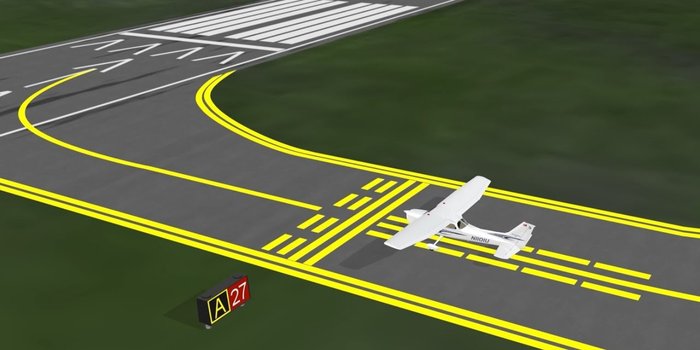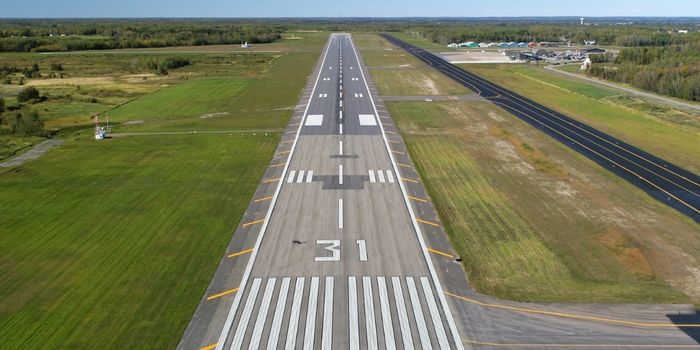Airports are very busy places with a lot of movement. Every plane, light, marking and sign has its own unique role to keep flight operations smooth and safe. Many people confuse taxiways and runways due to their flat paved paths where planes move.
Therefore, we have written about the differences between taxiways and runways, along with their purposes. Let’s understand in this easy guide!
What is a Taxiway in Airport?
A taxiway is a path at an airport. You see it on the ground where it is built to connect runways, terminals, hangars and other points of an airfield. You can move plans on taxiways to reach different areas of the airport.
Furthermore, you will notice various types of markings, lights and signs installed in this area. This guidance system assists pilots while they drive the airplanes on the ground.

Function of Taxiway in Airport
- Connects runways and terminals
- Links hangars and aprons
- Manage aircraft movement
- Safe ground operations
- Organizes traffic flow
- Mark clear routes
- Smooth takeoff & landing transitions
What is Runway?
At an airport, the runway is a long and flat strip. You can use it for planes to take off and land. Runways are marked with numbers and lines to guide pilots.
You will see lights along the edges and ends to direct planes during night or bad weather. These routes are strong and smooth to support heavy aircraft safely.

Difference Between Taxiway and Runway
Both taxiways and runways guide aircraft to move safely, but they are not same. The table below will show you the major difference.
| Main Feature | Taxiway | Runway |
| Surface Design | It has a smooth path which is made for slow aircraft movement on the ground. | Runway built with a long and strong strip designed for high-speed takeoff and landing. |
| Markings & Colors | You will see yellow pavement lines that direct the plane movement.
|
Runway markings are always white.
|
| Dimensions | Length: 2750 m to 3900 m
Width: 44 meters, including shoulder width |
Length: 2438 m to 3048 m
Width: Runways are around 45 meters wide |
| Lighting | The taxiway uses blue edge lights and green center lights to guide planes at night.
|
White edge lights and red or amber lights at the ends of runways are installed for landing and takeoff.
|
| Control Tower Role | Tower gives you taxi clearance and directions to aircraft & vehicles for safe ground movement | Flight controllers responsible for takeoff and landing clearance for aircraft. |
| Restrictions | Not used for takeoff or landing. You can only use it for ground movement. | Only used for takeoff and landing. Parking or taxiing is completely restricted |
| Common Violations | Enter the runway without permission or cross the wrong path | The landing or taking off without clearance or use of the wrong runway. |
| Operations | Responsible for safe flow of planes between runway, terminals, parking and hangars | Only handle the operations of aircraft which involve aircraft departure and arrival |
| Numbering System | Taxiways are marked with letters such as A, B, C or any combination. For example: A1, B2 or AA | But, runways are marked with numbers based on their magnetic direction (01 to 36). For example: 09 & 27 |
| Safety Rules | You have to follow speed limits and stay on painted markings | You must obey strict timing clearance rules before takeoff or landing |
| Construction Material | Designed with asphalt or concrete and optimized for reduced speed | Made of reinforced asphalt or concrete. They are built to handle heavy loads and high speeds. |
Why Are Runway Lights Blue?
Basically, you will not find blue lights on the runway because they are placed on taxiways. You can see them along the edges of taxiways to direct planes safely at night or in low visibility.
Blue lights are useful for pilots to stay on the taxiway and avoid entry at the runway by mistake. In contrast, runway lights are generally white or red, which show you the aircraft’s takeoff and landing paths.
What Color Are Taxiway Edge Lights?
Taxiway edges are marked with blue lights. These lights alert you to the boundary of the path. So, you can keep the aircraft within these edges while moving on the taxiway. Plus, they keep ground vehicles clear of the taxiway. You should follow the taxiway blue edge lights to avoid crashes in low-visibility conditions.
How To Read Taxiway Signs?
Taxiway signs are installed to guide pilots, so they can find the right path at an airport. You will see two main types of signs.
- Mandatory Signs mostly have a red background with white letters. They show you areas where you cannot enter without ATC permission.
- Direction Signs are usually yellow with arrows and black text. They lead you toward runways, terminals, parkings zones or other taxiways.
Longest Airport Runway in the World
The Qamdo Bamda Airport (BPX) in Tibet has one of the longest runways in the world. Its length is around 5500 meters (18045 feet). Moreover, the runway is so long because the airport is built at a very high altitude. It is also far from the nearest town (about 136 km from Qamdo), which makes it among the world’s farthest airports as well.
How Do Airports Decide Which Runway To Use
Actually airports select runways based on wind direction. That’s why planes take off and land into the wind for safety and better lift. Pilots also consider runway length, speed, traffic and weather conditions. Further, the control tower gives you clearance and tells you which runway to use.
Why Do Airports Switch Runway Directions?
Airports change runway paths to match the wind directions. Because, when you take off or land into the wind, it assists planes lift safely. Sometimes, weather or maintenance also requires a different direction. Also, the control tower decides and tells pilots which direction to move.
How To Read Airport Runway Signs?
You will see mainly six types of signs at runways.
-
- Mandatory Signs: Red background with white letters. They show you areas where you cannot enter without permission.
- Information & Direction Signs: These signs have a yellow background with black letters. They guide pilots toward runways, taxiways or terminals.
- Destination Signs: These signs inform you about the direction to other runways or taxiways.
- Locations Signs: Location signs tell you where you are on the airfield.
- Runway Distance Remaining: These signs tell pilots how much runway length is left during takeoff or landing.
Difference Between Runway and Runway Strip
The runway is the main surface where you can take off and land planes. It has markings, lights, number system and signs to guide pilots. On the other side, the runway strip is the open area around the runway.
It gives you extra space for safety if an aircraft moves out of runway. The runway strip is usually made of grass or soil (not hard pavement). With its use, you can protect the aircraft and reduce damage during an emergency.
Summary
So, are you planning to design a taxiway or runway? JACKWIN is your perfect partner. We offer high-quality marking machines and safety signs. We also provide a wide range of aviation safety products.
These include obstruction lights, beacon warning lights, safety barriers and many other tools used at airports. Contact us today to get a quick quote and right equipment solutions for your project.
Frequently Asked Questions
Is it Possible To Take off From a Taxiway?
No, it’s not allowed to take off from a taxiway. Because they are narrower and shorter than runways. Also, taxiways don’t have the markings or lights needed for safe takeoff.
What Happens if a Pilot Lands on the Wrong Runway?
If a pilot lands on the wrong runway, they must try to take off again and avoid any crash. After that, the case is checked by airport officials. The pilot may get a warning, need more training or lose their license if the mistake is serious.
What Do PAPI Lights Indicate on a Runway?
PAPI (precision approach path indicator) lights show pilots if they are landing at the right angle. You will notice red and white lights used to lead the plane. Two red and two white lights mean the plane is on the correct path for a safe landing.
Are There Any Airports With Multi-Level Taxiways?
This is rare but some airports have different taxiway levels. For example, Indira Gandhi International Airport in Delhi has a raised taxiway. However, most airports avoid this because building overpass taxiways is difficult and needs extra safety measures.
How Many Taxiways in the Airport?
It depends on the size and layout of the airport. Small airports may have just one or two, while in large airports, you may find many taxiways that connect runways and terminals. Each taxiway is designed to assist planes move safely and quickly around the airport.


-80x69.png)

